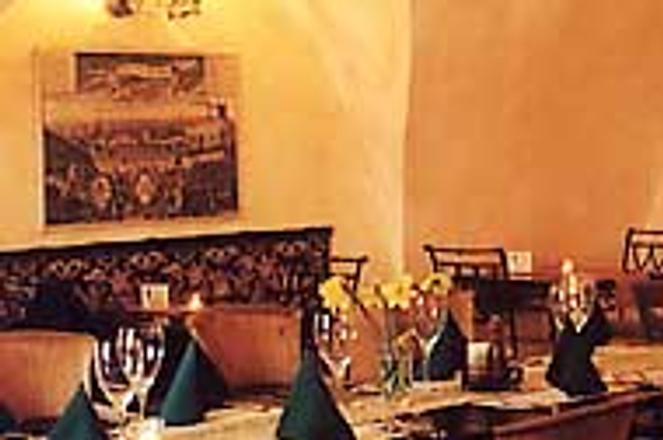THE BASEMENT hosts live concerts and theatre shows.photo: Courtesy of Woch
Restaurant Woch
Where: Františkánske námestie 7, Bratislava
Tel: 02/5443-2927
Open: Mon-Sun 11:00-24:00
English menu: Yes
Reservations: Yes
Rating: 8 out of 10
THE BUILDING that houses Bratislava's restaurant Woch has a rich history and is an interesting architectural mix. It has a 13th century medieval basement and its upper floors are from the baroque period. Additionally, it was the home of two prominent figures from the capital's past: The last woman to be burnt as a witch lived here, as did a knight who went by the name of Woch, the first known citizen of Bratislava and the person for whom the restaurant is named.
Situated just around the corner from the Main Square, the building has been recently reconstructed with the generous help of the city council. During the renovation, old frescoes were found and preserved. The restaurant's interior, which has an arched ceiling, keeps up the historic spirit of the place, and the chef has made it his task to revive traditional Bratislava cuisine.
It is rather difficult to define Bratislava fare, or Prešporok (from the German name for the capital, Pressburg), because it is influenced by many countries of the former Austro-Hungarian Empire. A characteristic example is schnitzel, which, when prepared in the classic Viennese manner, is made from veal. But it can be prepared with any other meat as well. In Woch it is made out of chicken. Dishes like the thick meat soup with vegetables called čorba show that food can travel from as far away as Bulgaria or Yugoslavia.
Our choice, the tomato soup, was not much of a thrill because it tasted like it was made of tinned tomato puree, not from fresh tomatoes. But both the main dishes we had were delicious. The grilled chicken Tabako was fine, flavoured with garlic and dill. The fried salmon was stuffed with spinach and served with a delicate mustard sauce.
One of the deserts, with the strange name of cisársky trhanec (emperor's torn-apart cake), is like the Austrian Kaiserschmarn, a fluffy pancake torn into small pieces, fried, and served with either fruit jam or stewed fruit. As with many other royal delicacies, this one could be a dish in itself. But when you make the mistake of having soup before the main dish, you might end up taking your desert home in a doggy bag.
The wine list features well-known wine producers and small vineyards using exciting new varieties of grape.
There were no objections to the service. The prices, though, were on the high side, even for a downtown restaurant. With the salmon costing almost Sk400 and the side dishes at around Sk100, like a medium-sized salad for Sk95, the bill can easily add up to more than Sk1,000 for two.
Woch makes possible a pleasant combination of food and culture. In the basement there is a music club with live concerts, mainly on weekends, and the F7 theatre is also on the premises, hosting among other performers the alternative Gunagu theatre group. Woch has established itself not only as part of Bratislava's gourmet scene but also as part of its nightlife.


